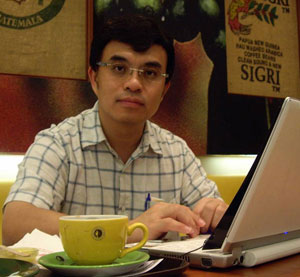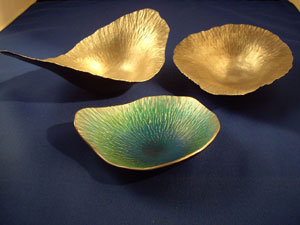MIRDC's Clad Metals Raise Added-value for Taiwan-made Metal Products
2009/05/07 | By Steve ChuangTo help Taiwan-based makers of metallic products of all kinds to achieve high added-value in their products, the MIRDC (Metal Industries Research and Development Centre), a Taiwan-based government-funded research institute, has been working on development of high-end clad metals and applications with aesthetic-value.

Since early 2008, an R&D team led by C.C. Huang, deputy director of the Metal Processing R&D Department of MIRDC in Kaohsiung City, southern Taiwan, supported by the Industrial Development Bureau under the Ministry of Economic Affairs, has been quietly busy with several metal processing technological projects, which has tapped industrial resources and expertise. The fruits of such labor have been the development of clad metals and related production methodologies, realized jointly with local companies in the metal and related industries, which have been applied in the real world.
Huang, in an interview, shares his thoughts and his R&D team's objectives.
Creating Better Opportunities
Expressed without hype and hypocrisy, Huang and his R&D team are simply trying to "create better opportunities for metalworkers and related makers in Taiwan," according to Huang.
"In 2007, Taiwan's metal industry recorded output value of NT$1.6 trillion (about US$50 billion at NT$32: US$1)," Huang says; however, "downstream makers turned out metallic products of only NT$800 billion that year, or about 50% of the total output. Such figure suggests that downstream suppliers in Taiwan are still not creating value-added metal products, or, in other words, most are still at the bottom of the pyramid."
Taiwan is an island with no valuable natural resources, so it is a serious lesson for metal product makers to maximize the per-unit-mass value of metallic materials used in production. Such feat can only be achieved by rolling out high-value-added metal products, which can only be made with cutting-edge innovations based on upgraded metals.

After doing an extensive market and industry survey covering supply-demand analysis, engineering materials, mold development, equipment and application research, Huang decided to devote efforts to enhancing added-value in products through technological upgrades, application of composites, and creative and artistic designs.
Precision Roll-bonding
Likely inspired by American and Japanese predecessors, Huang and his R&D team have been concentrating on development of a special production methodology: precision roll-bonding.
This precision roll-bonding technology, generating enormous pressure and high temperatures through rolling, firmly bonds sheet-metal as a base with others-reinforcing bonding between metal sheets-to turn out clad metal. Huang says that such production method has been widely used by many large international firms as Technical Materials, Inc. of the U.S., NEOMAX of Japan to develop new clad metals.
After successfully developing related machinery and repeatedly improving production processes, the team independently built an integrated line recently to turn out clad metals, from material in-feed, heating, heat treatment, rolling to precision roll-bonding. Also to allow line operators to effectively improve quality of output, the team has improved the process for diametrical integrity, symmetry and thermal control.
"We now can turn out clad metals composed of different metals as aluminum, nickel, copper, carbon steel, stainless steel and copper alloy," Huang states. "By roll-bonding different metals, we can develop clad metals to suit certain requirements."
Citing frying pans as example, Huang says that they have successfully built one of clad metals composed of stainless steel, copper and aluminum to achieve better abrasion-resistance, thermal conductivity and lightness. "The feat proves that clad metals effectively enhance functionality," Huang says. In addition, clad metals will also be used in 3C (computer, communication and consumer electronic), medical and transportation products.
Tap Indigenous Culture
Huang thinks that Taiwanese makers and designers can try to infuse more cultural ingredients in products to create added-value, tapping the centuries of rich tapestry of the island's aboriginal cultures. "In short, they can innovate by showing such cultural flavors on the product exterior, which can be achieved via clad metals," he says.
For instance, he adds, the NCVM (non conductive vacuum metallization) process can create a fluid, mercury-like finish on mobile phone housings, achieving double the value of a typical metal counterpart that captures consumer attention.
To further enhance the aesthetics of clad metals, Huang's R&D team has been developing precision processing technologies, along with traditional machining processes, like drilling, milling, rolling, casting and pressing, to surface-treat clad metals for improved tactile, visual appeal.
Applying CAE (computer aided engineering) technologies, the team has succeeded in using advanced laser machining and electroforming to finish clad metals. "Electroforming allows us to literally 'clone' metallic particles from one surface onto another to achieve a certain tactile, visual feature."
The team can currently electroform with nickel-cobalt alloy, copper, nickel, nickel-phosphorous alloy and nickel-fluorine alloy composite to finish clad metals to achieve innovative surfaces.
Plus, the aforementioned cutting-edge roll-bonding technology also enables makers to roll-bond up to 30 different metals to create special exterior patterns. So far, they have developed 200 clad metals with 30 exterior patterns, with such clad metals used as raw material to produce cutlery, mobile phone housing, and art objects.
Building Knowledge Database
Another goal of the clad metal project is for Huang's R&D team to build a digital database containing their research results, including composite metal surface and practical production methodologies, which is expected to be a reference for Taiwanese product designers as they look for innovative ideas to craft new items.
Besides, Huang's team is also trying to assist industrial designers by setting up an analytical tool based on ergonomic engineering and computation technology, which will systemize the design process-via clear analysis-to help create special metallic feel via analyzing material characteristics, such as chromaticity, brightness, composition and appearance, as well as people's physical and psychological perceptions toward a product.
Enriching Know-how
Likely buoyed by the prospects realized by Huang and his R&D team, the MIRDC has teamed up with the Taiwan Design Center to set up the "iF Material Showroom," where 13 building and industrial materials have been imported from Germany's iF, including clad metal, wool-leather cloth, ceramic, clay, cement, gypsum and glass and glass fiber, to build a platform to enrich material science know-how for Taiwanese industrial designers.
"Having developed clad metal technologies and set up the digital database, we aspire to encourage more metal and related product makers in Taiwan to innovate to turn out higher value-added products," Huang says. "Our achievements so far will help local makers produce high-end items of clad metals, and play a part to build a metal-design sector with output value estimated at NT$1 billion, push up the production value by NT$10 billion for the metalworking sector, and by NT$30 billion for downstream suppliers in the future," he concludes.

